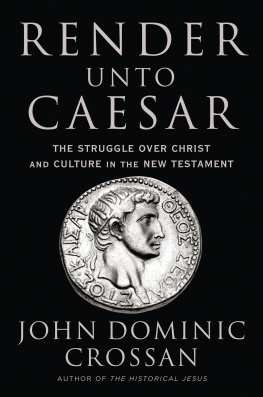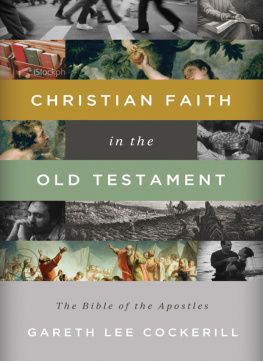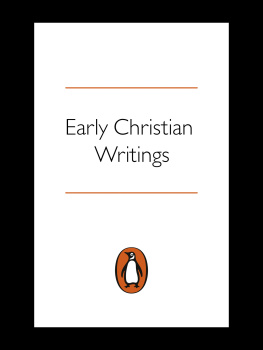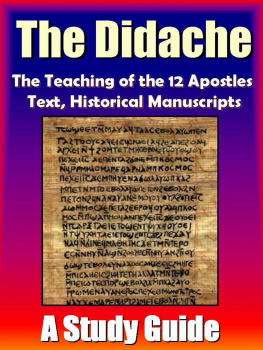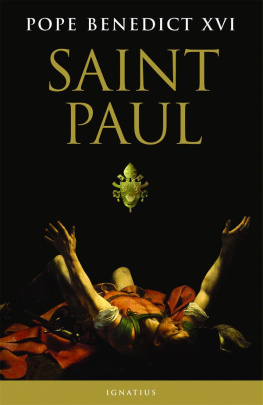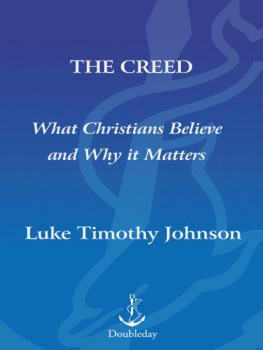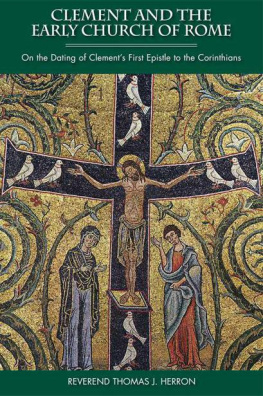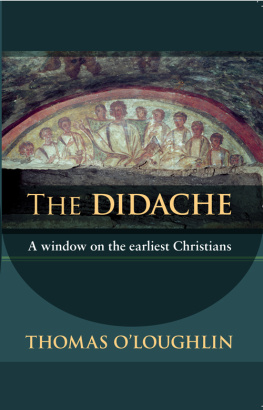Table of Contents
Clement of Rome and the Didache

A New Translation and Theological Commentary
KENNETH J. HOWELL
Early Christian Fathers Series: 2
CHResources
CHResources
PO Box 8290
Zanesville, OH 43702
740-450-1175
www.chnetwork.org
CHResources is a registered trademark of the
Coming Home Network International
(C) 2012 by Kenneth J. Howell
All rights reserved.
Printed in the United States of America
Library of Congress Cataloging-in-Publication Data
Howell, Kenneth J. (Kenneth James)
Clement of Rome and the Didache : a new translation and theological commentary / Kenneth J. Howell.
p.m.
Includes bibliographical references(p. ) and indexes.
ISBN 978-0-9830829-7-2 (alk. paper)
1. Clement I, Pope, d. ca. 99. 2. Clement I, Pope, d. ca. 99. Epistola adCorinthios. 3. Bible. N.T. Corinthians -- Criticism, interpretation, etc - -Early works to 1800. 4. Church history -- Primitive and early church, ca.30-600. 5. Didache. 6. Christian ethics -- Early works to 1800. I. Clement I,Pope. Epistola ad Corinthios. English. II. Didache. English. III. Title.
BR65.C56H69 2012
270.1--dc23
2012038689
Cover design and page layout by Jennifer Bitler www.doxologydesign.com
Index and ebook by Douglas Lowry www.MarpX.com
Dedication
Ad redintegrationem unitatis
omnium Christianorum dedicatum
PREFACE On Reading Ancient Christian Writings
{1} Clement of Rome's Letter to the Corinthians and the Teaching of the Twelve Apostles (the Didache) are unique among Christian writings. Of those that have survived antiquity, these are two of the most important writings for understanding Christianity in the second half of the first century. While no one can be absolutely certain of the dates of their composition, there is widespread agreement that they provide a unique window on the Christian church in the period soon after the New Testament. The only other documents that come close to their time are the seven letters of Ignatius of Antioch, which I made available in the first volume in this series. The purpose of these new translations and commentaries is to make direct contact with early Christian history possible for the educated non-specialist.
{2} The letter of Clement to the Corinthians has been read, translated, and used by scholars for centuries, as has the Didache since its discovery in 1873, but the concerns of scholars are not always those of my intended readers. These two seminal documents are too important to be read only by scholars of ancient Christianity. They are presented here so that Christians of all stripes may reflect on their importance for the contemporary practice of the Christian faith at both a personal and an institutional level.
{3} At the beginning of the third millennium of Christianity, there are compelling reasons to make available these early sources of the Christian faith, since there appears to be a renewed desire among Catholic, Orthodox, and Protestant believers to understand the history of their respective communions with regard to Christian antiquity. Many sense the relevance of that history for the articulation of the faith. All three traditions share common ground in the struggles, insights, and formulations of the first centuries of the church. The translations presented here seek to be fair to all Christians, and the interpretations, the introductory essays, and the commentaries are intended as an invitation for believers of all backgrounds to interact about the roots of their faith.
{4} The desire for a greater unity among traditional Christians has always lodged in the hearts of the baptized, but the last thirty years have brought that desire into more visible form. Dialogue and understanding of different ecclesial communions has increased in ways that would have been unthinkable one hundred years ago. Yet, this laudatory development occurs at the same time that many communions are floating on a doctrinal sea without an anchor. Some in these communions are consciously attempting to redefine Christian belief and morals. Others, fixed in churches rooted in tradition, stand in disbelief as they view these developments. It raises the question of standards. How can we know what is within the proper boundaries of Christian faith? This volume, like the first in this series, is dedicated to the restoration of Christian unity (ad redintegrationem unitatis omnium Christianorum). But these translations are offered with the conviction that a greater unity, if it is to be truly Christian, must be rooted in the historic sources of the faith, both in Scripture and in the earliest Christian fathers.
{5} However interpretations of these writings may differ, there can be no question as to their relevance and importance for our contemporary quest. I believe that every scholar has an obligation to divulge his leanings and inclinations. To do so, he must be hermeneutically self-conscious. I offer these translations, commentary, and interpretative essays with the awareness that my involvement in and commitment to the Catholic faith in union with the See of Peter has shaped my reading of Clement and the Didache. But what one brings to this reading does not have to prejudice the outcome. The text is there for all to investigate because ultimately meaning and interpretation are not arbitrary. They are discovered in the love and unity of the church, which reads earlier Christian history with a hope of passing on that faith to the next generation.
{6} Kenneth J. Howell
23 November 2012
Memorial of St. Clement of Rome
A Note on Text, Translation, and Scholarship
{7} In a work directed to the educated non-specialist, it is neither possible nor desirable to treat all the questions one may ask. I have therefore assumed positions on certain questions that scholarly readers may doubt, but I do not think those assumptions injure the most important aspects of my interpretations. I have sought to assume only those points of debate that seem relatively settled among expert scholars.
Texts
{8} For my translations, I have used standard modern editions of the Greek texts. While I do not assume that every textual variant chosen in modern critical editions is correct, I have largely taken the text used in Annie Jaubert's edition of Clment de Rome: pitre aux Corinthiens in the Sources Chrtiennes series (no. 167) that was first published in 1971 and reprinted in 2000. From the same series, I have used Willy Rordorf's and Andr Tulier's La Doctrine des Douze Aptres (no. 248bis) for the text of the Didache. These were put in digital form in the Thesaurus Linguae Graecae online.
Translation
{9} I have sought to find middle ground in my translations between too literal and too free-flowing, though I probably lean more to the literal, with the belief that this allows the reader to decide on interpretative matters. The reader will note the use of brackets [...] means that the word(s) contained are not in the original Greek but are inserted because they are strongly implied or necessary for clarification. All Greek words are cited in their lexical form to facilitate readers who do not know Greek. Occasionally, I have cited words in their inflected forms if it is relevant to the point under discussion. The Greek index has the meanings of some of the more prominent terms. Like any translator, I have consulted with previous English versions, but I have also used the French translations of Annie Jaubert and Willy Rordorf and the Italian translation of Antonio Quacquarelli. My thanks to Colin Howell for his explanations of the Italian, and Marie Jutras for hers of the French.


